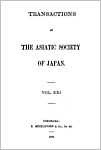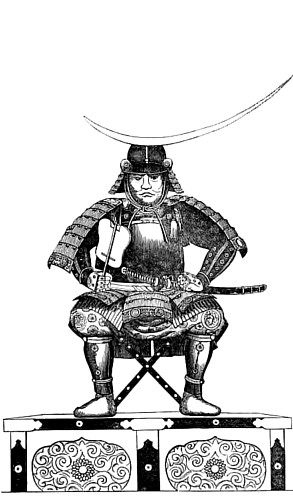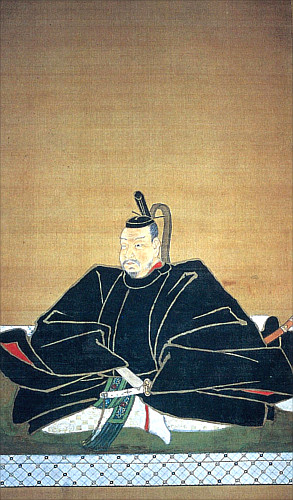La nuova scienzaColyer Meriwether1615: l'ambasceria di Date Masamune a Genova (1893) 1 |
La nuova scienzaColyer Meriwether1615: l'ambasceria di Date Masamune a Genova (1893) 1 |

 |
 |
Figura 1 – Date Masamune (1567-1636) nell'arte della guerra e nell'arte di governo 2
Having accomplished their mission in Spain and crossed that peninsula, they took passage on some feluccas and arrived at Genoa on the 12th October, 1615. The Document, Appendix II, No. 8, taken from the archives of Genoa and kindly handed to me by the Chevalier Belgrano, relates the reception afforded them by that city and the facilities granted them by the Senate in order to enable them to reach with the greatest possible promptitude and complete exoneration of custom-duties the eternal city, together with the numerous gifts they brought along from Japan for his Holiness the Pope. In this document we read for the first time a personal description of our ambassadors. One of them, says the document, was of Japanese nationality and was [<49-50>] called Don Filippo Fasecura; (sic) 3 the other a Spaniard of Sevilla, Luigi Sotelo by name, a Franciscan priest of the order of the "Osservanza." They have with them a train of 28 persons, for the most part Japanese, and these all are with the exception of one, of low stature, olive coloured; they have small eyes, little beard, and greatly resemble each other. Fasecura was dressed in long black-velvet tunic, over which he wore another, shorter one, of black silk; his stockings were of yellow silk, made almost like gloves, that is, with the big toe separated from the rest; and with leathern soles, and he also wore a black felt hat. The ambassador and his companions had their hair close shaved on the top of their head and on the rest of the head it was long and tied up on the back like a tail. He carried a most beautiful scimitar and also a sword. The other gentlemen wore similar tunics but less rich. They all ate with little chop-sticks. Father Sotelo wore the habit of the order and also acted as interpreter.
From Genoa the ambassadors went direct to Roma, bringing a letter of their prince to Pope Paul V [...].4
Father Mattia was received with much honor by the Republic [di Venezia]; his expenses were defrayed by the Senate, who also presented him with a gold chain and a medal of Saint Marcs (Appendix II, No. 14) and gave him likewise a crucifix and two silver lamps (Appendix II, No. 15) for the daimiō of Öshu and gave order to Carlo Albano, Venetian Consul at Genoa, to call upon Hasekura when the latter should pass through that city on his return to Spain and to thank him for the mission and do him honor in the name of the Republic.
The reception extended to father Gregorio Mattia and the presents of the Republic, were gratefully acknowledged by the Japanese envoys, which is proved by another document (Appendix II, No. 17) now extant in the State archives of Venice, and in which the warmest thanks are conveyed to the Senate, and the original also bears the signatures of Hasekura and of father Sotelo.
In this letter the envoys say that the receptions and the gifts were the more appreciated because extended in their absence; that their sovereign would learn of these occurrences [<52-53>] as a happy beginning to strengthen his sincere and eternal friendship and the mutual relations of the two states, more especially so as "a direct way of communication would soon be opened between Japan and Europe," and finally they say that father Gregorio, tired of travelling, will return to his native country and they recommend him to the Republic.
This letter was written at Genoa, where, as it appears from another document taken from those archives (Appendix II, No. 16), the ambassadors remained during a few days previous to their returning to Spain to embark for their country, following the same way they had come by.5
[Appendix II] No. 8.
VISIT AND COMPLIMENT PAID TO TWO AMBASSADORS OF THE
KING OF OSHU IN THE ISLAND OF JAPAN ON THEIR ARRIVAL AT
GENOA ON THE 12TH OCTOBER, 1615.
The Senate having heard that two ambassadors from one of the reigning sovereigns of Japan had just arrived from Spain and were lodged at the monastery of the "Annonciata del guastato" resolved to send them a delegation of four gentlemen to welcome them in the name of the Senate and greet them with the title of "lllustrissimi." One of the ambassadors was a Japanese called Don Filippo Faxecura, the other one a Spaniard of Sevilla called Luigi Sotelo, a Franciscan monk of the order of the "Osservanza," and both were going to Rome with a suite of twenty-eight gentlemen, mostly Japanese, to make act of obedience, in [<83-84>] the name of their sovereign, to His Holiness the Pope, having previously written from Savona to the Senate of Genoa requesting permission to land.
The deputation chosen by the Senate was composed of Oratio Lercars [Lercari]; G. B. Baliano; Nicolo Inorena;6 Paroli and Francesco Serra,7 who, having assembled as usual on "San Luca" square and being accompanied by a vice chancellor, two target guards and twenty German soldiers in cape and sword, repaired to the said monastery of the Annonciata, where they were met by Father Sotelo, near the entrance of the dormitory, who accompanied them to the door of their apartments. The Japanese ambassador received them a few steps from the door and having entered and being accomodated with seats, Signor Oratio, as the eldest of the Deputation, addressed them in a few chosen words. After which gifts were exchanged. The interpreter of the Deputation, Doctor Scipione Amati, translated into Spanish all what the deputies had said, which Father Sotelo immediately expressed in a low voice in Japanese to the other ambassador and the latter replied, and Father Sotelo interpreted for him in Spanish, thanking those gentlemen for the courtesies, honors and compliments done to them and added that he would give information of everything to his sovereign, by whom he had been particularly instructed to call upon the noble Senate of Genoa, well remembering the honors and compliments paid thirty years before to other Japanese Ambassadors who happened to pass through Genoa, and said he would also give his sovereign a written account of everything notable in the city of Genoa, and after a few more compliments he begged the commission would obtain from the Senate the concession of the three following requests, namely: To be excused for having been anticipated by their Lordships in paying the due compliments. That as they were carrying in the name of their king, presents to His Holiness the Pope, consisting of sacerdotal ornaments, alter vases and other [<84-85>] beautiful things peculiar to their country, they begged that everything should be let pass free of the usual custom duties, and their boxes should not be opened, just as had been done wherever they had passed. And finally that the Senate should recommend the interests of the Embassy to the Genoese Cardinals on account of their being identical with those of His Holiness and the catholic faith.
The commissioners replied that they would submit their requests to the Senate, whereupon they retired and were accompanied by the Japanese ambassador a few steps further than the place where he had received them; that is, as far as the corner of the dormitory, and by Father Sotelo and the rest of the Embassy to the very end of it.
On the afternoon the Ambassadors went to the Palace to return their visit to the commissioners, who were then assembled in the Senate. They were received on the top of the stair by two secretaries and conducted into the Senate hall and seated on the throne beside his "Serenity" the Doge, upon two velvet chairs. The Japanese sat on the right and the Spaniard on the left. The former having taken off his hat and greeted the assembly, addressed them in Japanese, but in such a low voice that they could scarcely hear the sound of it, and constantly keeping his face turned towards the Spaniard, who translated it afterwards into Spanish in a most accomplished manner, showing himself to be a very able and prudent man. His "Serenity" the Doge answered him in complimentary terms and always addressed him with the same title of "Illustrissimo."
They took leave by bowing to the assembled Senators, who returned the salute by removing their caps, and bending their heads, without however rising from their seats.
The two Secretaries accompanied them down stairs, and having got on a litter they were taken on board a galley of Don Carlo Doria, which was ready to start for Civista Vecchia [Civitavecchia] [<85-86>]
In ascending and descending the stairs of the Senate they were accompanied hy a guard of German halberdiers.
The Senate ordered the Custom authorities to let pass free of duty the baggage of the Embassy; they were not instructed however not to open them.
All those Japanese, except one, were of low stature, of a yellowish, almost olive tint, small eyes, with little or no beard; in their features they resemble each other very much. The dress of the Ambassador consisted of a gown which almost reached his feet but not very large, made of black velvet, and above it another, a much shorter one, with short large sleeves, made of black silk; yellow silk stockings; leather shoes resembling a glove, that is with the big toe incased separately from the rest, and a black felt hat on his head. The other Japanese were dressed the same but not so richly and without the long (?) gown. The ambassador and his suite wore their hair close-shaved on the top of the head, but so long on the temples that they turned them up on the back and tied them with a piece of silk string after the manner of a turned up tail. The ambassador also wore to his belt a kind of scymitar about two inches long [due palmi?], which the Japanese call "Katana."
His followers also wore a weapon of the same form and quality, but wore moreover, either in their hand or on one side, another but much longer one which they also call "Katana."
His courtiers made use in eating of two small chopsticks, two-thirds of an foot long, about as thick as our writing pen-holder, with which they very dexterously can bring to their mouth whatsoever they are eating.
The other Ambassador, that is, Father Sotelo, was dressed as a Franciscan monk belonging to the order of the "Osservanti dell'Annunziata del Guastato." 8
[Appendix II] No. 16.
VISIT AND COMPLIMENT PAID TO THE TWO ILLUSTRIOUS AMBASSADORS
OF THE KING OF OSHIU IN THE ISLAND OF JAPAN ON THEIR RETURN TO GENOA.
The Senate having heard that the two Japanese envoys of the King of Oshiu, who had returned from Rome on their way home and were lodged at the convent of "La Nontiata del Guastato," gave instructions that they should again be called upon by four gentlemen of the Senate and addressed again as "Illustrissimi." The four deputies, led by Magnifico Stefano Carmagusla,9 went to the Convent and met the Ambassadors in the new apartments just above the gate of the "Stanze."
As they took leave they were accompanied out of the gate through the "Loggia." [<92-93>]
The Japanese Ambassador, being indisposed, did not return the visit for some time; but when he and Father Sotelo called upon His Highness they were received with honor and addressed as "Illustrissimi;" they sat opposite to His Highness, and when they left they were accompanied two or three steps out of the Hall.10
1 C. Meriwether, "A sketch of the life of Date Masamune and an account of his embassy to Rome", Transactions of the Asiatic Society of Japan 21 (1893), pp. 1-105 ![]() Google libri e Internet Archive (per University of California); scheda bibliografica
Google libri e Internet Archive (per University of California); scheda bibliografica ![]() OPAC SBN. Sono stati corretti pochi refusi.
OPAC SBN. Sono stati corretti pochi refusi.
Informazioni essenziali su Date Masamune, daimyō di Sendai, in ![]() Wikipedia.
Idem per l'ambasciatore giapponese Tsunenaga Hasekura (1571-1622), in
Wikipedia.
Idem per l'ambasciatore giapponese Tsunenaga Hasekura (1571-1622), in ![]() Wikipedia EN.
Idem per il beato Luis Sotelo (1574-1624), in
Wikipedia EN.
Idem per il beato Luis Sotelo (1574-1624), in ![]() Wikipedia EN.
In merito alla delegazione di cui fa parte Baliani, di cui si cerca di precisare la composizione in alcune note che seguono, si tenga conto che "senatore" e "governatore" sono sinonimi.
Wikipedia EN.
In merito alla delegazione di cui fa parte Baliani, di cui si cerca di precisare la composizione in alcune note che seguono, si tenga conto che "senatore" e "governatore" sono sinonimi.
Rimane da consultare: Solenne ambasceria dal Giappone al sommo pontefice Paolo V, affidata al francescano padre Luigi Sotelo... (Prato, Tipografia Giachetti figlio e C., 1891) ![]() OPAC SBN.
OPAC SBN.
2 A sinistra: da una tavola fuori testo in Meriwether (1893) ![]() Google libri e Internet Archive.
A destra: dipinto di Mitsusada Tosa (1738-1806)
Google libri e Internet Archive.
A destra: dipinto di Mitsusada Tosa (1738-1806) ![]() Wikipedia EN.
Wikipedia EN.
3 Tsunenaga Hasekura, come accennato più sopra. P. Paesano, a cura di, Per desiderio di scorrere il mondo. Libri di viaggio della Biblioteca Angelica, 1330-1835 (Roma, Libreria dello Stato, 2006), p. 65; scheda bibliografica ![]() OPAC SBN.
OPAC SBN.
4 Meriwether (1893), pp. 49-50 ![]() Google libri e Internet Archive.
Google libri e Internet Archive.
"Si partirono di Madrid adì 22 di Agosto 1615 e navigando per il Mare Mediterraneo, diedero porto in Genova adì 11 di Ottobre, il che havendo saputo quella Serenissima Republica, ordinò subbito per loro commodità un Palazzo, qual fusse ornato, e con tutte quelle commodità, e spese provisto, che convenivano alla grandezza di quei Signori, & al gran personaggio che ricevere volevano: Ma per la fretta che questi Signori hebbero, invitati a seguitare la navigatione per Roma dal buon tempo che faceva, si contentarono quella sera di stare nel Convento dell'Annuntiata di S. Francesco, dove furono visitati da i principali tutti della Città, e fattoli molte carezze, & infinite offerte, il giorno seguente s'imbarcarono, e doppo sette giorni giunsero a Civita Vecchia, che fu adì 18 giorno di S. Luca Evangelista". Relatione della solenne entrata fatta in Roma da D. Filippo Francesco Faxicura, con il Reverendiss. Padre fra Luigi Sotelo descalzo dell'Ordine Min. Offer. Ambasciadori per Idate Massamune re di Voxu nel Giapone. Alla Santità di N. S. Papa Paolo V l'Anno XI del suo Ponteficato (Roma, G. Mascardi, 1615), p. 4 ![]() Google libri (per Österreichische Nationalbibliothek, Wien); scheda bibliografica
Google libri (per Österreichische Nationalbibliothek, Wien); scheda bibliografica ![]() OPAC SBN.
OPAC SBN.
Una relazione ben più estesa, ma sempre priva dei nomi dei magistrati genovesi, è in: S. Amati, Historia del regno di Voxu del Giapone... (Roma, G. Mascardi, 1615), pp. 53-55 ![]() Google libri (per Biblioteca Nazionale Centrale di Roma) e Internet Culturale (per Biblioteca Nazionale Centrale di Firenze); scheda bibliografica
Google libri (per Biblioteca Nazionale Centrale di Roma) e Internet Culturale (per Biblioteca Nazionale Centrale di Firenze); scheda bibliografica ![]() OPAC SBN. Il brano che sicuramente riguarda Baliani è il seguente: "La mattina seguente [lo sbarco a Genova dell'ambasceria giapponese] la Repubblica inviò due Segretarij, e due Mazzieri per saper quando il Serenissimo Duce poteva complire con l'Ambasciata, e mostrar il gusto, che sentiva d'una venuta tanto remota d'Ambasciatori a Sua Santità, e prescrittasi l'hora vennero quattro Senatori, & esposero l'offitio di compimento con S. E. nel quale servendo il Dottore Amati per interprete della lingua Spagnuola, & Italiana si consumò mezz'hora in detta visita con molto contento de i Signori Ambasciatori per l'offerte, e gratissime demostrationi di cortesia, che significarono verso l'Ambasciata" (p. 53).
OPAC SBN. Il brano che sicuramente riguarda Baliani è il seguente: "La mattina seguente [lo sbarco a Genova dell'ambasceria giapponese] la Repubblica inviò due Segretarij, e due Mazzieri per saper quando il Serenissimo Duce poteva complire con l'Ambasciata, e mostrar il gusto, che sentiva d'una venuta tanto remota d'Ambasciatori a Sua Santità, e prescrittasi l'hora vennero quattro Senatori, & esposero l'offitio di compimento con S. E. nel quale servendo il Dottore Amati per interprete della lingua Spagnuola, & Italiana si consumò mezz'hora in detta visita con molto contento de i Signori Ambasciatori per l'offerte, e gratissime demostrationi di cortesia, che significarono verso l'Ambasciata" (p. 53).
5 Meriwether (1893), pp. 52-53 ![]() Google libri e Internet Archive.
Google libri e Internet Archive.
6 Presumibilmente Nicolò Invrea quondam Francesco, che era stato eletto governatore il 13 giugno 1613; si ricorda che questa e le altre magistrature nell'esecutivo avevano una durata biennale. Cfr. V. M. Coronelli, "Cronologia de' Governatori e Procuratori della Repubblica di Genova, estratti dal Bussolo del Seminario dall'anno 1576, e' hebbe il principio, fino all'anno 1692", in Cronologia Universale, che facilita lo studio di qualumque storia... (Venezia, 1707), p. 486 ![]() Google libri (per Österreichische Nationalbibliothek, Wien); scheda bibliografica
Google libri (per Österreichische Nationalbibliothek, Wien); scheda bibliografica ![]() OPAC SBN.
OPAC SBN.
7 Che il primo possa essere identificato con Gio. Pietro Serra quondam Francesco? Era stato eletto governatore il 9 aprile 1615. Francesco Serra quondam Antonio sarà eletto governatore il 13 giugno 1619. Cfr. Coronelli (1707), p. 486.
8 Meriwether (1893), pp. 83-86 ![]() Google libri e Internet Archive.
Google libri e Internet Archive.
9 Presumibilmente Stefano Carmagnola quondam Paolo, che sarà eletto governatore il 23 novembre 1617. Cfr. Coronelli (1707), p. 486.
10 Meriwether (1893), pp. 92-93 ![]() Google libri e Internet Archive.
Google libri e Internet Archive.
